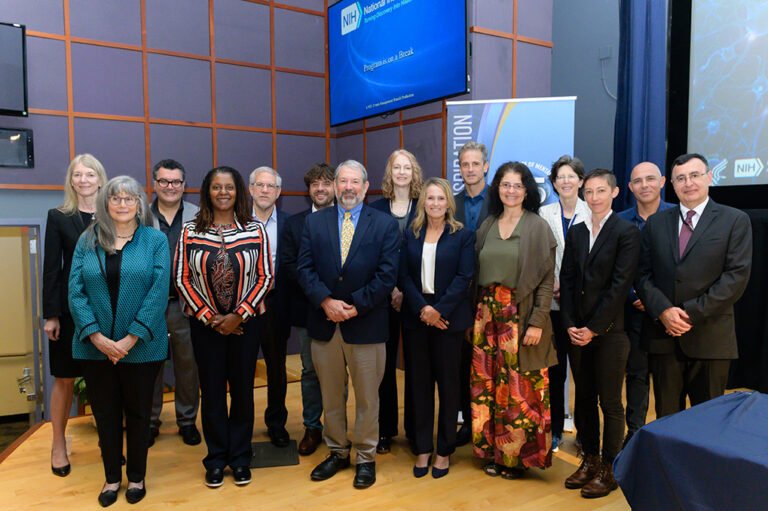• Institute update • 75th anniversary
The National Institute of Mental Health (NIMH) began celebrating its 75th anniversary on September 13, kicking off its annual festivities with a symposium, “The Evolution of Mental Health Research”. Hundreds of people gathered in person and virtually to contemplate what NIMH Director Joshua A. Gordon, MD, Ph.D., called “the most complex object in the universe”—the human brain.
The symposium covered the development of research on brain structure and function. During the event, researchers gave presentations on discoveries covering topics from the time scales of nervous systems to the physical makeup of the brain.
Dr. Gordon opened the symposium by noting that approximately 1 in 5 adults in the US experience mental illness.
“The cost to society is enormous,” he said. “The cost to individuals’ families and communities is even greater—and everyone in this room knows it. he knows it from personal experience or by observing it in a family member or close friend.”
Noting how improvements in mental health care did not happen by accident, Dr. Gordon said NIMH-funded research has led to important breakthroughs in mental health care, such as drugs for depression. Cognitive behavioral therapy? and coordinated specialist care, which is the standard of care for early psychosis. NIMH’s goal now, as it was when it was founded in 1949, is to advance research that helps people and families with mental illness, he said.
First Keynote: Integrating Brain Function in Time and Space
Cori Bargmann, Ph.D. , a professor at Rockefeller University, gave the first keynote address. In her talk, Dr. Bargmann presented evidence that the nervous system can create different “internal states” corresponding to emotional states that guide its ability to produce behaviors. These flexible, reversible states share “ancient links” with innate behavior in humans, mice and even worms.
A characteristic of many internal states is that they are particularly influenced by neuromodulators—neuropeptides and other small molecules such as serotonin and dopamine that change the way information flows through neural circuits. Many existing psychiatric drugs mimic or suppress the brain’s neuromodulators.
Internal states can be associated with everything from sleep and hunger to mood and social behavior. And while people can make conscious choices about their actions, biologically regulated internal states play an active role in influencing motivation, emotion and behavior, Dr. Bargmann said.
“I don’t mean to say that we don’t have cognitive functions, rich experiences, individual human capacities and free will to guide our behavior,” he said. “But … there is a biology that underlies all behavior and all brain functions, and it’s good to know when you’re working with that biology and when you’re working against it.”
By better understanding neuromodulators and the biological process of change in internal states, researchers can continue to advance our knowledge of mental health, he said.
Second keynote: Inner workings of microbial membrane proteins… and the brain
Professor at Stanford University Karl Deisseroth, MD, Ph.D., DH , presented the second keynote address. Dr. Deisseroth covered the topics of memory, anxiety and dissociation, which he said were not always easy to measure. His talk focused on improving ways to measure the brain structures that direct these processes.
One of the ways neuroscientists explore brain function is through a technique known as optogenetics. Originally developed by Dr. Deisseroth, the method uses light to modify the electrical activity of cells, including neurons in the brain, and influence behavior.
Using stress as an example, Dr. Deisseroth noted that optogenetic studies in animals have allowed researchers to better understand which parts of the brain are involved in behaviors associated with symptoms of anxiety disorders.
View the evolution of science
Among other highlights of the symposium, researchers gave talks on topics that included brain mapping, improvements in electroconvulsive therapy and the often lengthy development process for depression drugs. Researchers also participated in panel discussions, taking questions from the audience and further discussing their work.
Outside the auditorium, researchers from the NIMH’s Division of Intramural Research Programs participated in a poster session presenting their line of research conducted across the institute.
This symposium was the first of three NIMH anniversary symposia. NIMH looks forward to hosting the next symposium, “Amplifying Voices and Building Bridges: Toward a More Inclusive Future,” on March 18, which will focus on issues of inclusion related to defining mental illness, workforce inclusion, and access to research and its results.
Learn more about NIMH’s 75th anniversary here. To watch the presentations from the first symposium, visit NIH videocast .
